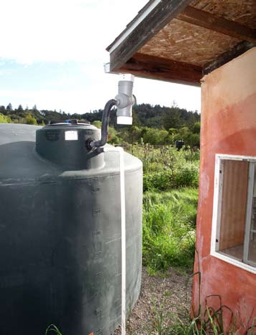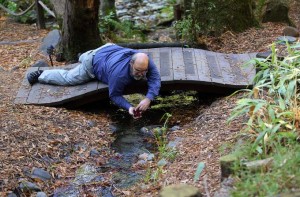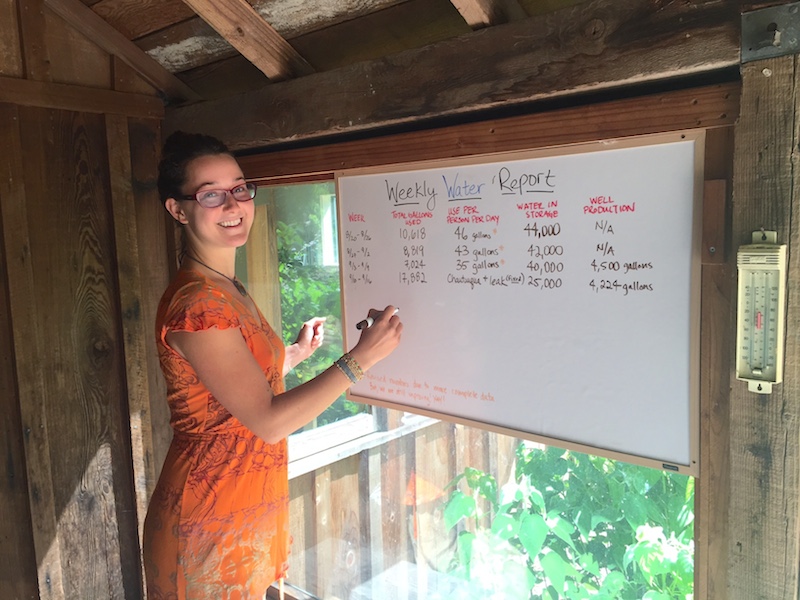Above: Alana records weekly potable water use at OAEC outside the Main Office, which all staff members see throughout the day. You, too, could do this at your workplace, church, child’s school, etc., to help your community keep water conservation in mind.
Water Budgeting
Record drought conditions have dramatically slowed OAEC’s already low producing well, inspiring us to enact emergency potable water conservation measures across our site. The situation at OAEC is symbolic of what California is dealing with as a whole. While all people draw water from some limited source, those of us not connected to municipal water are acutely aware of our source’s limitations.
From a management perspective, we must all function within the “water budget” specific to our unique place. In order to be in right relationship with your water, we encourage you to learn more about your water supply, so you can budget your use appropriately—even if you are part of a municipal water system. And once you empower yourself to understand water budgeting and conservation at the household scale, you will be able to implement water conservation practices at a larger community scale.
When thinking about your water budget, the analogy of money can help you gain a deeper understanding. How much of it do you have; how much do you “spend” and where do you tend to spend it; where can you cut your spending; and how can you earn (in this case, store) more of it?
At OAEC, we take weekly readings of our well production and of our water usage, then use that information to calculate how many days of water we have left. This allows us to understand when we are exceeding our water budget, which leads to staff-wide discussions about changing our behavior to conserve as much as possible. Our goal, of course, is to never use more water than our well is producing.
If you are on municipal water, your water bill may inform you of how much water you consume (check out this EPA article about understanding your bill). If not, look online for common usage patterns for your area. The average American uses about 100 gallons per person per day, but the ideal would be to use less than 30 per person per day—15 indoor, 15 outdoor (this number is an estimation and varies depending on your unique ecosystem and watershed).
Store Your Own Rainwater!
 A great way for your household to begin taking action is to store rainwater. We as Californians do not live in a water scarce area, as staff member Brock Dolman puts in, but a storage scarce area. Massive amounts of rain run straight to the ocean instead of seeping into the ground, due to impervious surfaces like roads and rooftops. Well, it’s that time of year to start thinking about harvesting the free water that is (hopefully) about to be falling from the sky!
A great way for your household to begin taking action is to store rainwater. We as Californians do not live in a water scarce area, as staff member Brock Dolman puts in, but a storage scarce area. Massive amounts of rain run straight to the ocean instead of seeping into the ground, due to impervious surfaces like roads and rooftops. Well, it’s that time of year to start thinking about harvesting the free water that is (hopefully) about to be falling from the sky!
The OAEC WATER Institute pioneered the creation of the inexpensive “wonder gutter” method for roofwater catchment (view the DIY guide), which can be seen on our the goat shed to capture the water needed for the community’s animals. For this simple, affordable roofwater catchment system, all you need is a 3-inch corrugated drainpipe, a food-grade 55-gallon drum, and a few plumbing parts. It costs under $100 to install, and even if you are a renter, you can disassemble the system and reinstall it elsewhere.
By storing your own water, you will develop a personal relationship with it. If every day you can see how much water is in your tank, you will take more responsibility for your water usage!
Other ways to conserve and reuse water in your household:
- Showers: keep a 5-gallon bucket in your shower, then use the water you collect to flush your toilets. It’s the cheapest, easiest graywater system around!
- Dishwashing: put plastic basins into your sink to capture water as you are washing dishes, then water your plants with it.
- Leaks: check around your house for leaks: toilets, showers and hoses. Constant water drip can cost you or your municipal system hundreds of gallons a day. If you are not sure how to check for leaks, engage your community. There may be a neighbor who would be happy to help you!
- Create swales: if you are a landowner, capture water on your land using swales, which slow runoff by spreading it horizontally across the landscape. It is vital for our watersheds to allow as much water as possible to infiltrate our soil! (Check out the “Slow It. Spread It. Sink It. Store It!” guide, to which the WATER Institute contributed.)
“Watergy”—Another Reason to Conserve
Did you know that conserving water will lower your energy bill? “Watergy” is a term referring to the energy it takes to move water, each gallon of which weighs 8.34 pounds. So, each gallon that does not go down the drain is water that doesn’t need to be pumped away as wastewater. By reducing the amount of water that goes down your drain, you are conserving resources and saving money.
Take Action
Thank you for taking the time to explore the ideas and resources presented in this post. The realities of the California drought are calling us all to act now. Remember–once you understand water budgeting at a household scale, you will be empowered to implement water conservation measures for your whole community. So, try it today!
More drought resources from OAEC’s WATER Institute >
Local Water News:
Human Conservation Saves Fish in Dutch Bill Creek

Our Sonoma County neighbors in Camp Meeker have achieved the water conservation goal of using 30 gallons per person per day. This frugality has allowed them to “donate” some of their water to coho salmon and steelhead trout in the dangerously low Dutch Bill Creek (view the Press Democrat article or learn more through the National Fish and Wildlife Foundation)
OAEC’s Brock Dolman first suggested that the community release water into the creek years ago, but the idea “never had legs” until the four-year drought finally made it appealing. “It seemed like such a no-brainer, just putting in a valve (on the Camp Meeker water tank) and a pipe,” Brock is quoted in the Press Democrat.
Thank you to our Camp Meeker neighbors for your water conservation, and for working with the Russian River Coho Resources Partnership to make the pipeline release a reality this year. All humans have the responsibility to conserve water not just for ourselves, but to make sure that every other species has enough to thrive, as well—such as the greatly endangered coho salmon.






